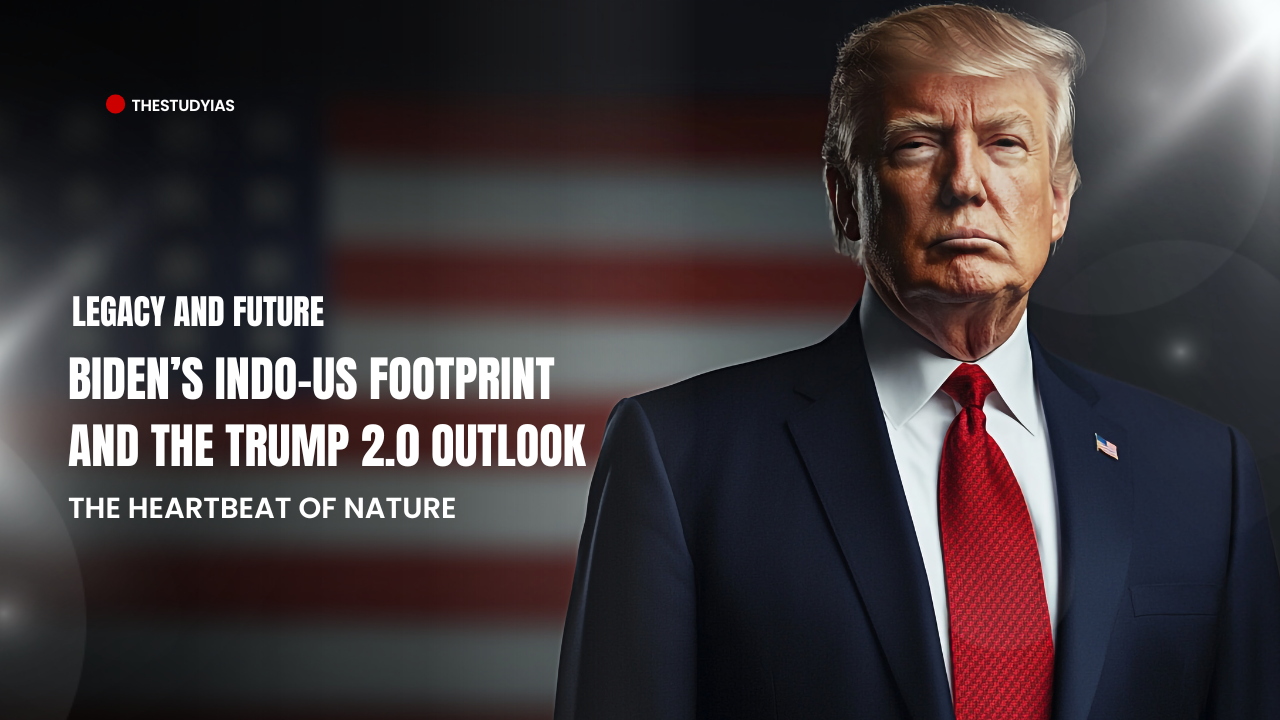Legacy and Future: Biden’s Indo-US Footprint and the Trump 2.0 Outlook
Introduction
India and the United States share a long history of diplomatic relations that have evolved over time. During the Cold War, the two countries were not very close, but in the 21st century, their partnership has grown stronger. Both nations share common interests in democracy, trade, and security, particularly in the Indo-Pacific region. Under President Joe Biden (2021–2024), India-US ties improved in many areas, including defence, trade, and technology.
Biden believed in working together with other countries and supported India’s role in global affairs. However, as Donald Trump returned to the White House for a second term in January 2025, his policies are expected to bring some changes. Trump prefers a transactional approach, meaning he expects direct benefits from partnerships. This could lead to challenges in areas like trade and immigration, though defence and security ties are expected to remain strong. This essay examines Biden’s legacy in India-US relations and explores how Trump’s return might shape the future of this important partnership.
Biden’s Legacy: A Strong and Stable Partnership
President Joe Biden worked to strengthen India-US relations through long-term policies that focused on defence, technology, and trade. He believed in multilateralism, meaning he preferred working with multiple countries rather than making deals with just one nation at a time. This approach helped India and the US grow closer through various initiatives.
Defence and Security Cooperation: Under Biden, India and the US increased their military cooperation, focusing on the Indo-Pacific region. The two countries, along with Japan and Australia, are part of a strategic group called the Quadrilateral Security Dialogue (Quad). This alliance was strengthened under Biden, with frequent meetings and military exercises to ensure security in the region. The US also helped India modernise its military. Under Biden, India purchased advanced weapons and aircraft, including Apache helicopters and P-8I surveillance planes. Joint military exercises and technology-sharing agreements helped India improve its defence capabilities, making it a stronger security partner for the US.
Economic and Technological Cooperation: Economic ties between India and the US flourished under Biden. The US is India’s largest trading partner, and trade between the two countries reached record levels. The Biden administration supported collaboration in key technological areas such as artificial intelligence, quantum computing, and semiconductor manufacturing. One of the major initiatives under Biden was the Initiative on Critical and Emerging Technologies (iCET), which encouraged innovation and cooperation in high-tech sectors. Another programme, the India-US Defense Acceleration Ecosystem (INDUS-X), helped India and the US work together on military technology and defence production.
Challenges Under Biden: Despite these achievements, some issues caused tensions between the two countries. Trade disputes, particularly concerning tariffs and market access, remained unresolved. India’s neutral stance on the Russia-Ukraine war also led to some disagreements, as the US wanted stronger action against Russia. Additionally, concerns over human rights and democratic freedoms in India were raised by the US, though these issues did not significantly impact overall relations.
Trump 2.0: The Future of India-US Relations
As Donald Trump begins his second term, India and the US are likely to continue their strong partnership. However, some of Trump’s policies might create challenges, particularly in areas like trade, immigration, and energy.
Defence and Security: A Strong Partnership Continues: Defence cooperation between India and the US is expected to remain a top priority under Trump. He has always supported strong military ties and arms sales, and he is likely to encourage India to buy more American weapons. The Quad alliance will continue to play a major role in regional security, though Trump may expect India to take on more responsibilities in maintaining stability in the Indo-Pacific. Technology and space cooperation, which grew under Biden, will likely continue under Trump. However, his focus on private sector involvement means that American companies such as SpaceX and Lockheed Martin may have more influence in these partnerships.
Trade — Potential Conflicts Over Tariffs: Trade relations between India and the US could become more complicated under Trump. During his first term, he took a tough stance on trade, removing India’s benefits under the Generalized System of Preferences (GSP), which had allowed some Indian goods to enter the US duty-free. This led to trade tensions, with India imposing retaliatory tariffs on American goods. Trump’s return might bring similar challenges. He is expected to demand that India reduce its trade surplus with the US by purchasing more American goods, including military equipment and energy exports. India, however, may resist pressure to change its trade policies too much, as it seeks to protect its own industries.
Immigration — A Tougher Policy on Indian Workers: One of the biggest concerns for India under Trump’s second term is immigration. During his first term, he imposed restrictions on H-1B visas, which are crucial for Indian professionals working in the US. Many Indian tech workers rely on these visas to work for American companies such as Google, Microsoft, and Apple. If Trump tightens visa rules again, it could negatively affect Indian workers and students who wish to study or work in the US. It could also reduce the amount of money sent back to India by Indian professionals working in America, impacting the Indian economy.
Energy and Climate Policy: A Shift Away from Green Energy
Under Biden, the US and India worked together on clean energy initiatives, focusing on renewable energy sources like solar and wind power. Trump, however, is expected to shift focus towards fossil fuels, promoting oil and gas exports to India instead. This change could have mixed effects. While India relies on fossil fuels for much of its energy needs, it is also investing heavily in renewable energy. A reduced focus on clean energy cooperation with the US could slow down India’s transition to greener energy sources.
China and Russia: A Delicate Balance
Both India and the US see China as a major strategic challenge, and this shared concern will keep them aligned on security issues. However, Trump’s aggressive policies towards China, such as high tariffs and economic restrictions, could create additional pressure on India to take a firmer stance against Beijing. India, which has important economic ties with China, will have to carefully balance its relations with both countries.
On the issue of Russia, Trump may take a more relaxed approach compared to Biden. This could benefit India, as it maintains strong defence and energy relations with Russia. If Trump reduces US pressure on India to distance itself from Moscow, it could ease some diplomatic tensions.
How India Can Adapt to Trump’s Policies
India has always prioritised strategic autonomy, meaning it does not strictly align with any one major power but instead seeks to maintain flexibility in its international relations. Under Trump’s second term, India will need to carefully manage its relations with the US while ensuring that its economic and security interests are not compromised.
One approach will be to strengthen its partnerships with other global powers, such as the European Union and Japan, to balance any uncertainties in US policies. Besides, India could increase its efforts to become a global manufacturing hub, attracting companies that are looking to move away from China. This would help India take advantage of Trump’s “China Plus One” policy, which encourages businesses to diversify their supply chains.
Conclusion
India and the United States have built a strong partnership over the years, and this relationship is expected to continue under Trump’s second term. Defence cooperation and strategic alignment in the Indo-Pacific will remain key pillars of this partnership. However, Trump’s transactional approach to foreign policy could bring challenges in trade, immigration, and energy cooperation.
India will need to deal with these changes carefully to maintain its strategic autonomy while benefiting from its relationship with the US. By balancing its ties with multiple global powers and adapting to shifting policies, India can ensure that its partnership with the US remains strong and mutually beneficial. Despite the potential challenges, the future of India-US relations remains bright, with opportunities for growth in various sectors.
Subscribe to our Youtube Channel for more Valuable Content – TheStudyias
Download the App to Subscribe to our Courses – Thestudyias
The Source’s Authority and Ownership of the Article is Claimed By THE STUDY IAS BY MANIKANT SINGH




